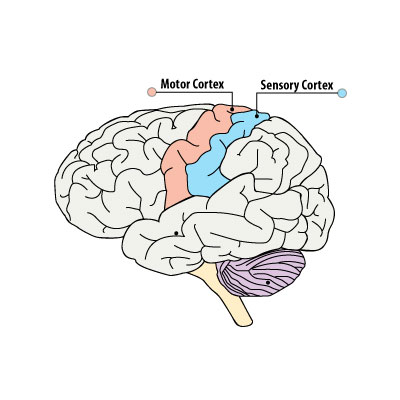In this post, I described The Green Light Reflex. When this reflex becomes habituated, it can often cause back pain, particularly in the low back.
But how does the Green Light Reflex cause back pain?
When the thick strong muscles of the spine, known collectively as paravertebrals, are involuntarily stuck in contraction (SMA) they draw the spinal vertebra closer together, this causes the lower back to arch forward excessively. This is often referred to as lordosis, or lordotic posture. It is easily identified by a lower back that is pulled to the front, it also makes the belly protrude and tilts the pelvis anteriorly.
Neutral posture (left), and a typical Green Light posture (right)
Some points to notice, in the figure on the right.
- The excessive arching of the lumbar spine
- The change in angle of the rib cage and pelvis due to the tightening of the back muscles
- The drawing drawing back of the shoulders and head
- The corresponding forward position of the hips
- The hyperextension of the hips and kness
- The protuding of the belly as a result of the overarched low back
When these paravertebrals are stuck in contraction, they will make any type of forward bending action more difficult. In order to bend forward freely, you must be able to relax and lengthen all the muscles along the back of the spine. If you cannot voluntarily relax and lengthen these muscles you have what we call in Clinical Somatic Education, Sensory Motor Amnesia (SMA).
Paravertebrals
Paravertebrals (the muscles running either side along the length of the spine) that are habitually contracted pull the vertebra (bones of the spine) closer together. This can compress any or all of the nerves that exit the spinal cord in the lumbar area or any other area of the back, leading to trapped nerves, sciatica or similar complaints.
This compression of the spinal vertebra can also create a situation where the intervertebral discs that are supposed to act as shock absorbers between each vertebra, are pushed out of place leading to bulging/herniated discs. This spinal compression is also what causes “wear & tear” in the lumbar spine. Even if you don’t have nerve pain or bulging discs from habituated Green Light Reflex, the constant contraction of the paravertebrals leads to fatigue and aching muscles in the back.
So an habituated Green Light Reflex can be the cause of several problems from a reduction in mobility all the way to herniated discs. Each of these problems occur along a spectrum of Green Light Reflex. At the low end of the scale, .ie minimal green light reflex you might expect to have reduced forward bending ability, and at the high end of the scale you might expect, tension headaches, chronic pain and bulging or herniated discs.
These are not the only issues that can occur as a result of habituated Green Light Reflex. It can also lead to tension headaches, neck pain, shoulder pain, tight hips, hamstrings and calves, knee pain and other issues. But the mechanism by which these problems occurs is the same. Chronic involuntary contraction (SMA) of all the muscles of the back of the body. In the image below those muscles are highlighted in green.
So what can we do about it? Well in truth the solution is quite simple. We must RELEARN optimal control of all the muscles of the back of the body. When we relearn proper control we will have the ability to relax and lengthen these muscles to their full and proper resting length. When this has been achieved pain is reduced or eliminated and movement quality improves.
How do we relearn proper control of these muscles? We pandiculate them using safe simple Somatics Exercises or through a series of Hands On Clinical Somatic Lessons. If you would like to learn how to release and relax all the muscles of the Green Light Reflex for a looser more comfortable back and freer movement, try one of my online classes here.
~














